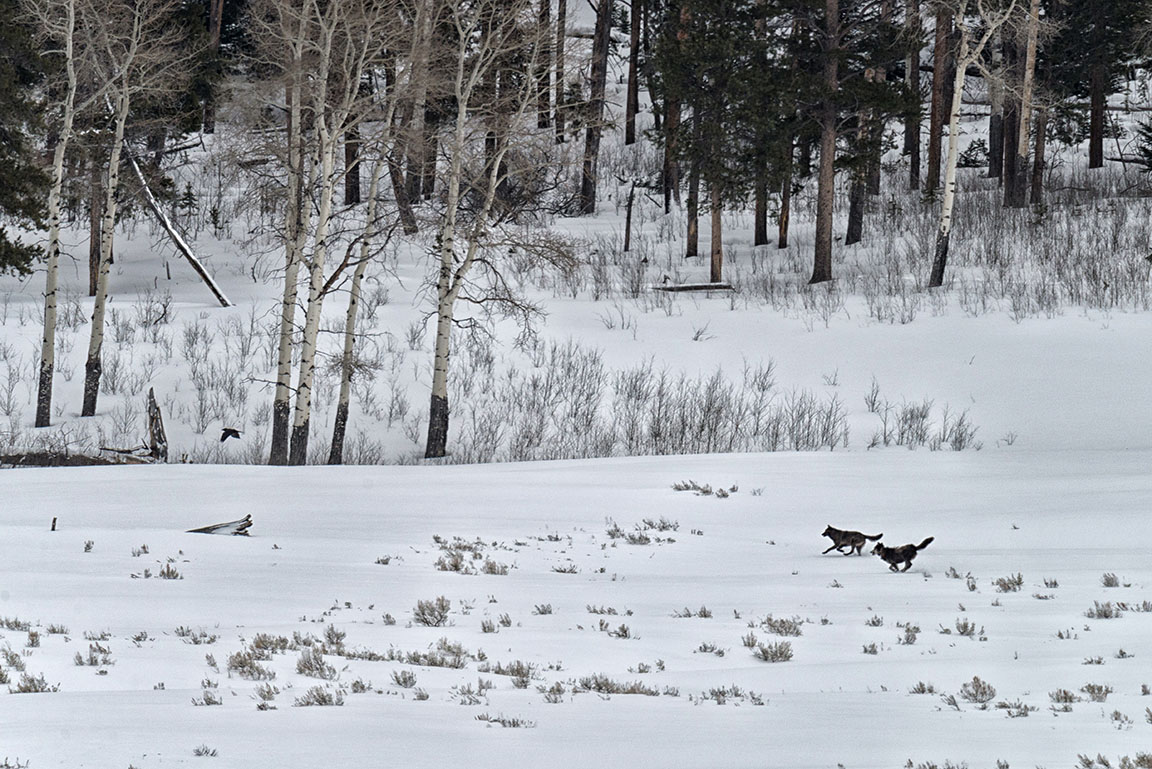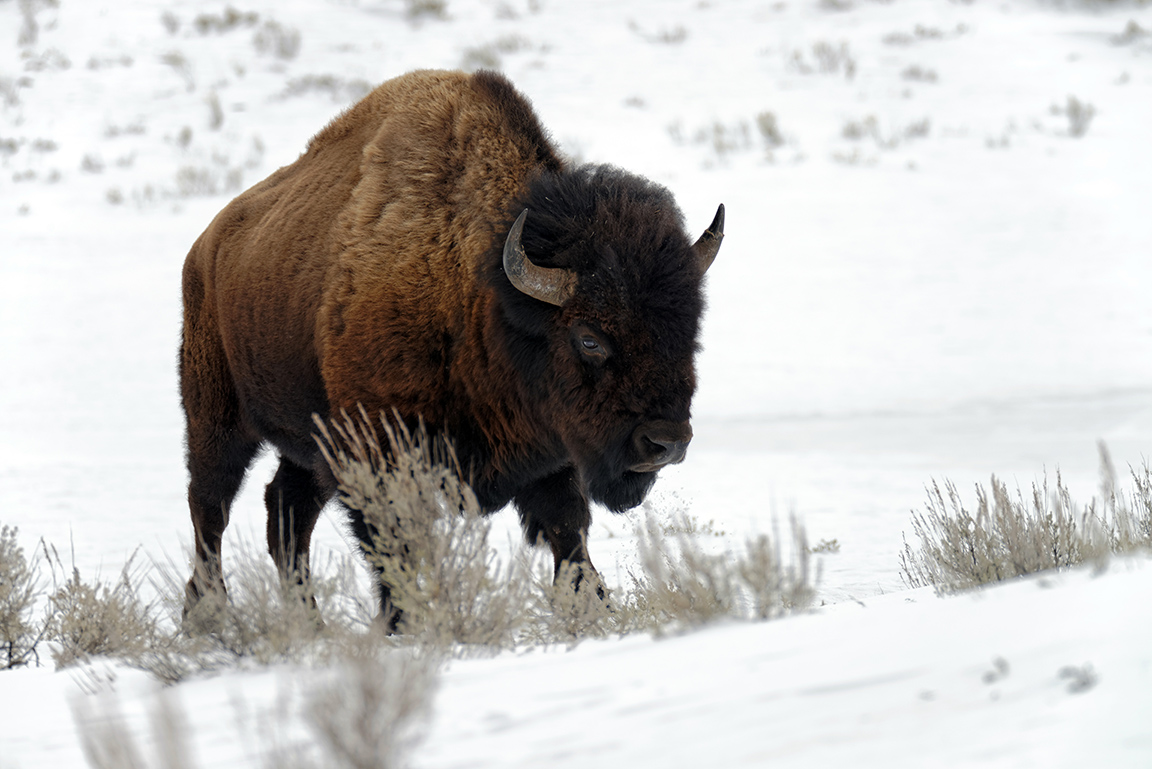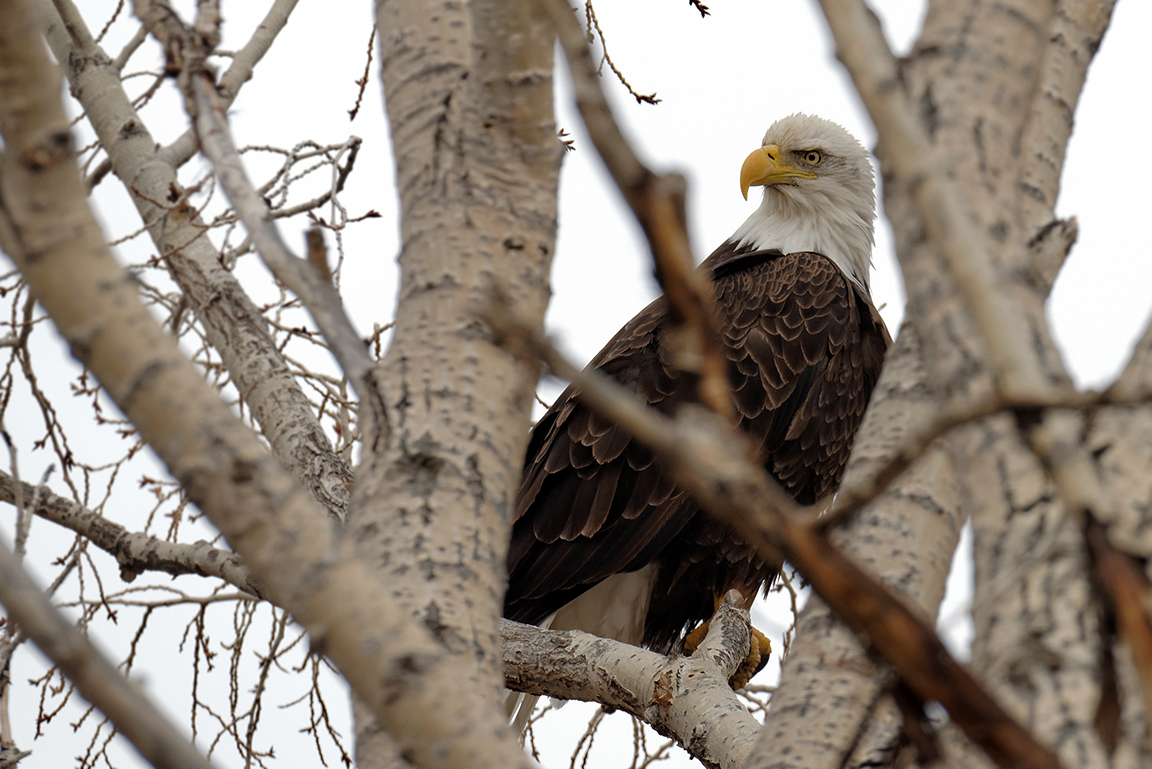By Mac Mirabile, WWF
I recently returned from an unforgettable wolf photo safari trip in Yellowstone National Park. While wolves were certainly our main target each day, there were ample opportunities to photograph bison, coyotes, red foxes, pronghorn, elk, deer and dozens of bird species along the way. Much of the trip was spent in Yellowstone’s Lamar Valley, commonly referred to as “America’s Serengeti” due to the area’s abundance of megafauna. As wildlife tend to be most active at sunrise and sunset, our tour group’s days began well before dawn and typically ended after 8 p.m.
The rich variety of wildlife we encountered is due in part to the reintroduction of wolves to the park in 1995. “It’s one of the all-time great stories of conservation,” said Natural Habitat Adventures guide Colby Brokvist, explaining that the wolves’ presence has reshaped the local ecosystem. “We have seen a resurgence of willow and aspen trees, greater biodiversity, and healthier animals. It is a conservation story you can actually see when we are there in the park. We visit sites to tell the story of the wolf’s reintroduction.”
Our first full day together was spent traveling from Bozeman, Montana, and entering Yellowstone through the only year-round entrance to the park in Gardiner, MT. As we drove under the famous Roosevelt Arch and read its inscription “For the benefit and enjoyment of the people,” I was reminded that Yellowstone was America’s first national park. After multiple expeditions returned photographs and paintings of the lands, its wildlife, and unique geothermal features, Congress and President Ulysses S. Grant were compelled to protect the area, setting it aside as a national park in 1872. Seeing it for myself I could easily imagine the impulse to protect and preserve such an incredible wonder of nature.
Although Yellowstone hosts about 4 million visitors annually, the November through April months are very slow – with less than 1,000 visitors per day. There is a good reason for this: Yellowstone in the winter is either cold, windy, snowing, or – if you’re lucky – all three. While the elements can certainly make for an uncomfortable photography experience at times, they present an excellent opportunity to the photographer ready to embrace Mother Nature and all that she offers. It was about 25°F with strong winds and snow when we pulled over to photograph some Bison across the road. I was struggling with how to capture the millions of individual snowflakes in the scene as well as capturing the strong winds, blowing them violently across the scene. Some quick experimentation with shutter speeds showed me that 1/30 would provide ample snow streaking and 1/500 would give me sharp flakes. Because I wanted both – in a single picture – I was limited to the equivalent of a film double exposure. I made two equivalent exposures in quick succession, maintaining my f/10 aperture, but altering my shutter speed and ISO. Overlaying the images in Photoshop and blending them gave me the look I was after – a picture of a pair of Bison braving the strong wind and heavy snow.

A pair of Bison braves the winter weather in Yellowstone. © WWF-US/Mac Mirabile
Technical Specifications: f/10, 1/30 & 1/640, ISO 100 & ISO 800, 150mm, 150’ focal distance shot with Nikon D600, Sigma 150-600mm Sport
For the first few nights of the tour, we stayed in Cooke City, a small Montana town with a year-round population of less than 100. Driving into Cooke City for the first time, we encountered 10 feet high snow drifts blocking the entrances of most of the town’s stores which were closed for winter. Cooke City averages more than 200 inches of snow annually, a fact corroborated by our experience seeing the town overrun with snow mobiles and only the occasional lull in snowfall.
The second morning we set up our gear in the Lamar Valley at the pulloff near the Soda Butte Cone after one of the guests in our van spotted a wolf walking in the snow. The previous day some wolves from the Lamar Canyon pack had killed a bull elk near the tree line ½ mile away, and a team of wolf researchers was watching the site, waiting for the wolves to return. After watching a lone wolf briefly revisit the kill and leave, the site was visited by ravens, magpies, a golden eagle and a pair of coyotes which were vigilantly listening and watching for any signs of the wolf’s return. Within an hour the scavenging coyotes were spooked and one fled toward the road where our group was positioned. As the coyote ran in our direction, I had ample time to increase my shutter speed and check my aperture and ISO. As the coyote alternated between running from the kill site and pausing to look back, I fired off about 100 shots, many in continuous focus mode. My favorite image shows the coyote with all four paws off the ground fleeing the site in a full sprint. The coyote was more than 100 yards away, but with my 600mm telephoto zoom lens and 1.4X teleconverter, I was able to get a fairly tight shot at 840mm on my full frame Nikon D600. My camera and lens were attached to my tripod with a gimbal head, allowing me to easily pan with the coyote as it ran. I opted for a 1/2000 shutter speed to freeze the action and an f/10 aperture to maximize sharpness of the lens.

A coyote flees the site of a recent wolf kill in the Lamar Valley in Yellowstone. © WWF-US/Mac Mirabile
Technical Specifications: f/10, 1/2000, ISO 800, 840mm, 400’+ focal distance shot with Nikon D600, Sigma 150-600mm Sport with Sigma 1.4x teleconverter.
After the excitement of the coyote there was very little action in the area. Our guides Kurt Johnson and Colby Brokvist made the most of the downtime by setting up an impromptu wolf tracking lecture with one of the wolf researchers. The researcher explained that they collar and track about 1/3 of the wolves in Yellowstone, especially the alphas and pups. We learned that these collars, both VHF and GPS, play a crucial role in helping researchers and volunteer wolf watchers locate and study wolves through scopes. The actual collaring process also allows a team to quickly measure, weigh and draw blood samples from the sedated wolves, allowing scientists to check for diseases within the population and understand a wolf’s pedigree.
The next morning, we returned to the same location to find a pair of Lamar Canyon wolves resting in the snow a few hundred yards from the kill site. Within 10 minutes a coyote wandered too close, and the wolves chased it from the site. This image was taken from about ½ mile away with my lens and teleconverter giving me a combined reach of 750mm. Even at that focal distance, the image is heavily cropped to show more detail, such as the red tracking collar on one of the wolves. I like this image particularly because of a pair of contrasts between the dark fur of the wolves and the snow and the barren aspen trees and the evergreens in the background.
We were very fortunate to have gotten to the site when we did at 8:15 a.m. Just 30 minutes after our arrival, the wolves left the site and according to the wolf watchers who stayed, the wolves did not return the rest of the day.

A pair from the Lamar Valley wolf pack chases after a coyote (not pictured) in the Lamar Valley in Yellowstone in early March, 2017.
Technical Specifications: f/10, 1/800, ISO 640, 750mm, ½ mile focal distance shot with Nikon D600, Sigma 150-600mm Sport and Sigma 1.4x teleconverter

Nat Hab tour participants set up their cameras and tripods and spotting scopes and wait for wolves to return to the site of an elk kill in Yellowstone’s Lamar Valley. © WWF-US/Mac Mirabile
A short drive from Cooke City – just a few hundred yards from one of the many wolf crossing signs dotting the highway – is the cabin of local photographer and Silver Gate resident Dan Hartman. An avid WWF supporter and true naturalist, Mr. Hartman shared over lunch some of his favorite shots and several tips for capturing unique wildlife moments. Mr. Hartman also leads tours for National Geographic and the BBC, and his property has been used in multiple nature documentaries. We viewed the local wildlife from the interior of his cabin, utilizing open doors and windows to photograph the birds and Pine Martens that have become habituated to the sights of long lenses peering through.
Although one could have some success with following a bird around the yard as it flies from branch to branch, the amount of camera movement and constant refocusing and recomposing is substantial with this method. I did manage a nice shot of a Hairy Woodpecker, but his movement was very camera friendly as he slowly and regularly ascended the tree, providing an ideal opportunity to photograph him in profile.

A Hairy Woodpecker looks for food in rural Silver Gate, MT, near the northeast entrance to Yellowstone. © WWF-US/Mac Mirabile
Technical Specifications: f/8, 1/100, ISO 200, 300mm, 18’ focal distance shot with Nikon D600, Sigma 150-600mm Sport
A better plan for more irregular movement involves locating and pre-focusing on a likely perching spot with a clean background and waiting for the bird to come into your frame. I used this technique photographing both the Pine Grosbeak and the Steller’s Jay. As I was able to rest my lens on the window sill, I was able to use a slower shutter speed which gave me a usable ISO 2500 for the images. The detail in the feathers and catch lights in the birds’ eyes are important aspects to consider when selecting between the dozens of shots of each species. The single most important element, however, is the sharpness of the subject’s eye(s) as this is where our eyes go first. A sharp focus is required for the viewer to make a strong connection with the subject. The images also each share a common compositional theme of placing the subject using the rule of thirds and ensuring that each is gazing across the length of the frame.

A Steller’s Jay rests momentarily on a tree branch in rural Silver Gate, MT, near the northeast entrance to Yellowstone. © WWF-US/Mac Mirabile
Technical Specifications: f/6.3, 1/200, ISO 2500, 600mm, 20’ focal distance shot with Nikon D600, Sigma 150-600mm Sport

A Pine Grosbeak rests on a tree stump in the falling snow in rural Silver Gate, MT, near the northeast entrance to Yellowstone. © WWF-US/Mac Mirabile
Technical Specifications: f/7.1, 1/500, ISO 2500, 600mm, 16’ focal distance shot with Nikon D600, Sigma 150-600mm Sport
The group had been photographing a male Pine Marten as he scurried among trees when he disappeared from view and a smaller female Pine Marten suddenly appeared. The female climbed into a dead tree where she momentarily disappeared. Mr. Hartman told us to point our cameras at a small tree cavity and wait. Within a few seconds she pushed her head through and looked around, seemingly posing for the half dozen cameras pointed in her direction. Leveraging Mr. Hartman’s knowledge of these resident Pine Martens’ behavior and a pre-composition of the scene, I was able to capture this fleeting wildlife moment.

A female Pine Martin pokes her head out of a tree cavity in rural Silver Gate, MT, near the northeast entrance to Yellowstone. © WWF-US/Mac Mirabile
Technical Specifications: f/8, 1/640, ISO 1600, 600mm, 18’ focal distance shot with Nikon D600, Sigma 150-600mm Sport
The next morning, we had no luck with the wolves, but focused on bison and landscape shots. Although we missed a moose encounter by just a few minutes, we were rewarded with a bull elk a few dozen yards into the forest of the side of the road near Mammoth Hot Springs within an hour. Such is life when photographing wildlife – you have to be at the right place at the right time. The next photograph coincides with a serendipitous decision to use the bathrooms in the Visitor’s center, where we encountered a small group of Bison grazing in front of the Dining Room, which recently closed for the season. Shooting from the opened door of our van, I used my wide angle lens to capture the bison and building in a single shot. These grazing bison framed against the backdrop of the Visitor Center Dining Room is a playful contrast that engages the viewer’s sense of humor.

A group of Bison graze outside the Visitor Center Dining Room in Yellowstone. © WWF-US/Mac Mirabile
Technical Specifications: f/8, 1/1600, ISO 720, 24mm, 8’ focal distance shot with Nikon D600, Nikon 18-35mm
That evening we visited the home of Bob Landis, an Emmy award-winning cinematographer and documentary filmmaker. He previewed for the group some of the stunning wildlife sequences shot in the last year and discussed his equipment, approach to film making and many of its challenges. He explained that the declining elk population and hunting of wolves outside Yellowstone have made candid wolf behavior much more difficult to observe now.
Although the wolves were elusive and quite distant when they were in view, the opposite was true for the iconic bison. There are approximately 4,500 bison within Yellowstone today. Solitary and small herds of bison were just about everywhere, making photo ops a common occurrence. Most of the bison we encountered were either grazing or meandering towards a new source of food, often using the same roads and bridges as the vehicular traffic. One of my favorite bison images from the trip is one of a bull climbing a hill, snow covering everything in sight except a few patches of sagebrush in the foreground. This image was shot with a small positive exposure compensation to brighten the snow and reveal the details in the bison’s face. The texture of the bison’s hair and horns contrasts sharply with the barren snow-covered background. Shooting from a slightly elevated position allowed me to utilize the snow as a background, rather than a mixture of ground, trees and mountains that would have existed had I been shooting from the bison’s eye level.

A Bison climbs a hill in Yellowstone. © WWF-US/Mac Mirabile
Technical Specifications: f/8, 1/640, ISO 500, 500mm, 200’ focal distance shot with Nikon D600, Sigma 150-600mm
Throughout the trip, the guides were constantly on the lookout for birds and opportunities to photograph them in the still of winter. We encountered more than 20 species of birds during the trip, including a pair of common Goldeneye one morning. The guides suggested we move to a continuous focus mode to capture the birds in flight. Within moments, we had our chance as the pair suddenly took flight and quickly streaked past our cameras. Their speed made it difficult to maintain focus, so I quickly zoomed out and reframed to capture the pair amidst the majestic snow-covered landscape.

A pair of Common Goldeneye in Yellowstone. © WWF-US/Mac Mirabile
Technical Specifications: f/9, 1/2000, ISO 400, 220mm, 120’ focal distance shot with Nikon D600, Sigma 150-600mm Sport
The last day of the trip concluded with a final trek in the area nearest Gardiner where we revisited the pronghorn and mule deer which reside at the edges of the park. Our slow deliberate pace allowed us to approach a bald eagle perched on a low branch in tree less than 100 feet from our van. We popped up the safari-style hatches and were slowly maneuvered into place by our guide as he positioned us for a relatively clear shot. I zoomed all the way in for a tight shot and did my best to focus on the eagle, hidden among the tree limbs. I stopped down to F10 to provide a greater depth of field, which allowed for more error with my point of focus. Within moments of my taking my last pictures in Yellowstone, the eagle had taken flight back into park, back into the wilderness.




























